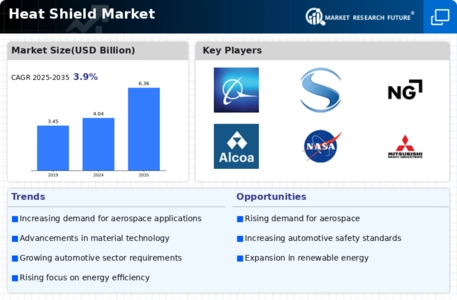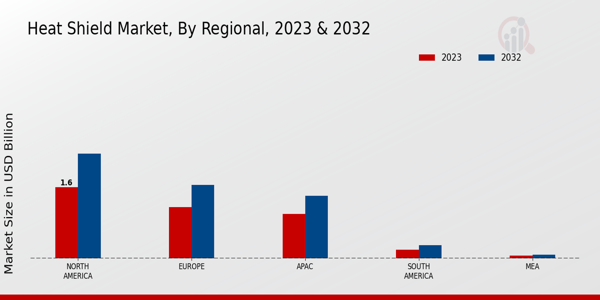Market Trends
Introduction
The heat shield market in 2023 is influenced by several macroeconomic factors. Especially technological innovations, especially in the field of materials science and aeronautics, will lead to innovations in heat shield design and functionality. Regulators are pushing for the use of more efficient and sustainable materials. Furthermore, changes in consumer behavior, such as the growing demand for advanced aeronautics applications and space exploration, are changing the market's dynamics. This is important for the heat shield market's participants to understand. This not only provides a better understanding of the opportunities in the market, but also the strategic importance of a rapidly changing market.
Top Trends
-
Increased Demand for Lightweight Materials
The aeronautical industry is adopting more and more lightweight materials for heat shields, so as to reduce fuel consumption. Using advanced composites, companies like Boeing and SpaceX can reduce weight by as much as 30 per cent. This not only reduces operating costs, but also increases the payload. Demand for such materials is expected to rise considerably in the future as a result of the tighter emissions regulations. -
Advancements in Thermal Protection Systems
In this field of research, NASA and Lockheed are working on the development of a system of protection against heat, with particular emphasis on the properties of materials which can withstand extreme temperatures. For example, the heat shield for the Orion spacecraft developed by NASA is made of a new ceramic-matrix composite. These developments are essential for future deep-space missions, and they could lead to more robust and reliable spacecraft. -
Integration of Smart Technologies
Smart heatshields are beginning to be a reality. Companies are experimenting with real-time sensors that can monitor the performance of heatshields. Northrop Grumman is one company that is working on smart heatshields. These smart heatshields can increase safety and the efficiency of space operations. They can also lead to a greater reliance on robots to operate spacecraft in the future. -
Sustainability and Eco-Friendly Materials
A growing emphasis is being placed on the use of sustainable materials in the heat shield market. Recyclable composites can reduce the impact on the environment, which is in line with the global goal of sustainable development. This trend will influence the procurement and product development strategies of companies that seek to comply with the requirements of both the regulatory authorities and the consumers. -
Government Investments in Space Exploration
Governmental subsidies to the space program have accelerated the development of heat-shields. For example, the U.S. government has allocated billions of dollars to the Artemis program, which requires the most advanced heat-shield technology. This infusion of capital has had the effect of stimulating further research and development and bringing the industry together. -
Focus on Reusability
The heat shield is being redesigned in the race for re-usable spacecraft. SpaceX is a prime mover. Their Falcon 9 rockets have heat shields that can withstand repeated re-entries, thereby reducing costs. This new design will be followed in future as the re-usability of spacecraft becomes the norm. -
Collaboration Between Industry and Academia
The collaboration between industry and universities has led to innovation in heat shield technology. Universities and Hexcel are working together to develop new materials with improved heat conductivity. This collaboration is expected to accelerate the development of next-generation heat shields and positively influence the market. -
Emergence of Hypersonic Technologies
The rise of hypersonic technology creates new opportunities and challenges for the manufacturer of heat shields. Various companies are developing materials that are resistant to the extreme conditions of hypersonic flight, as can be seen from the projects of Raytheon Technologies. This development is expected to increase the demand for specialized heat shields for defense and space applications. -
Customization and Tailored Solutions
There is an increasing demand for heat shields tailored to the specific mission requirements. Safran, for example, offers its own design adapted to the unique thermal conditions encountered. This trend is bringing satisfaction to the customer and operational efficiency, because it optimizes the performance of the various applications. -
Regulatory Compliance and Safety Standards
The heat shield market is influenced by stricter regulatory requirements and safety standards. The FAA, for example, has set new guidelines for heat shields. These standards are continually being refined, and the companies must adapt their products to meet these standards. This drives innovation but also increases costs. This trend reflects the importance of compliance for maintaining market share and ensuring the safety of air operations.
Conclusion: Navigating the Heat Shield Market Landscape
The Heat Shield Market by 2023 is characterized by intense competition and considerable fragmentation. Besides, the market is characterized by the presence of a large number of companies that compete for a share of the market. The geographical trends show a growing focus on the use of sustainable and advanced materials. The competition is between the established companies, which are based on the established relationships and the production capabilities, and the newcomers, which are based on the agility and the use of new and modern technologies, such as artificial intelligence and automation. As the market evolves, the ability to implement sustainable practices, enhance operational flexibility and use data-driven insights will be critical for market leaders. These capabilities must be the main focus of the decision-makers to navigate the market's complexities and seize emerging opportunities.













Leave a Comment